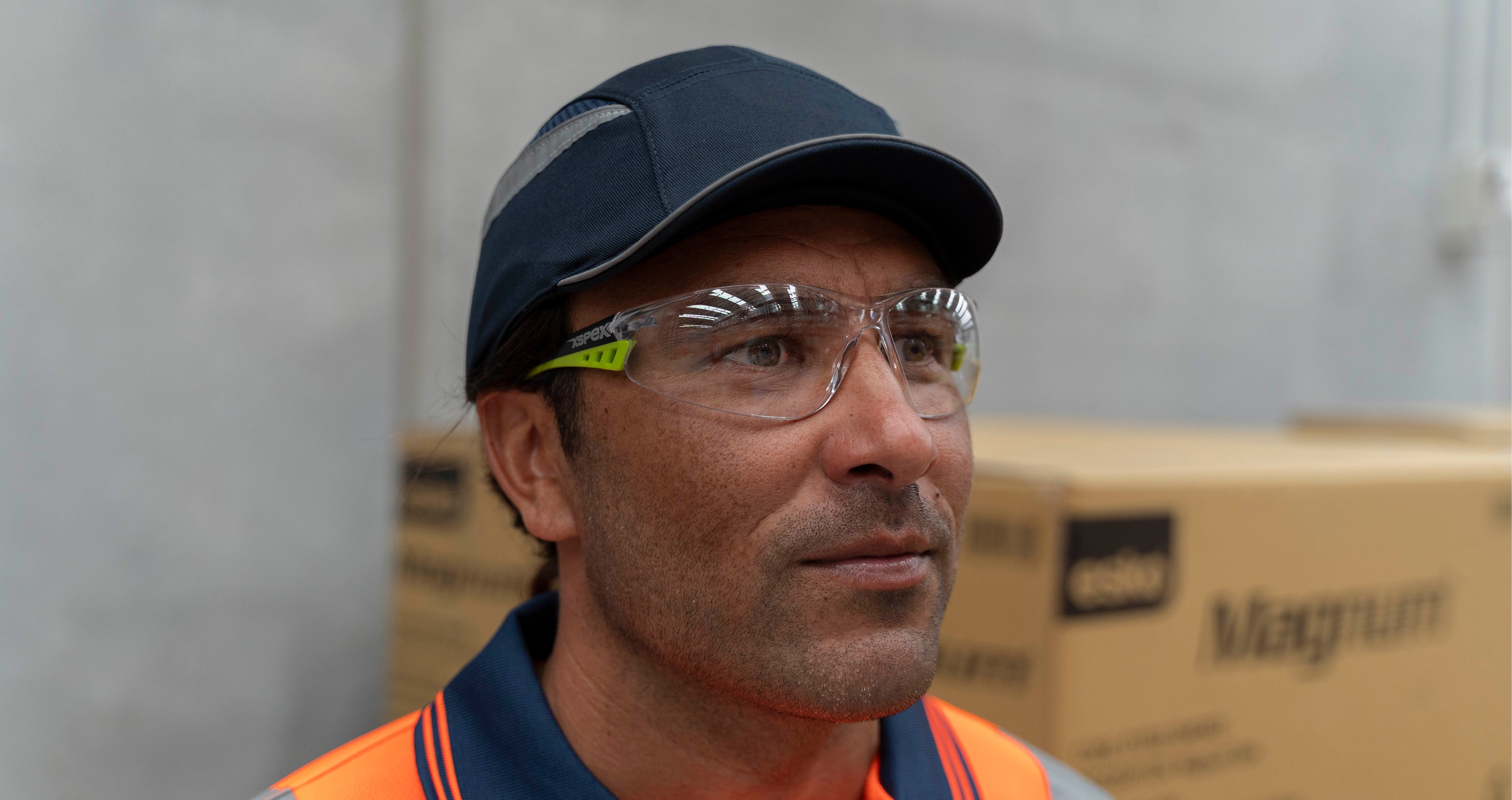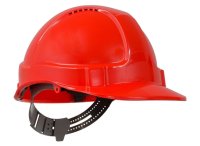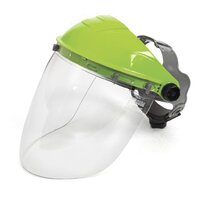head and face protection
Almost all construction work involves some risk of head injury
Hard hats provide head protection against falling objects, protruding items, electrical hazards, rain and UV exposure. As a result, an increasing number of employers are making wearing hard hats on their worksites mandatory at all times.
At a minimum, hard hats should be worn any time when:
Hard hats have a hard outer shell designed to deflect or absorb an initial impact, and a harness (sometimes called a suspension) which absorbs and spreads the impact, minimising the effects of a blow to the skull. The wearer should ensure the harness is adjusted to be comfortable and to provide overall contact with the head.
Esko hard hat shells are constructed from ABS (Acrylonitrile-Butadiene-Styrene) plastic, which has an excellent combination of impact resistance, durability, rigidity and flexibility, as well as an attractively smooth surface.
At a minimum, hard hats should be worn any time when:
- Work is being carried out overhead
- There is any risk of falling objects
- There is potential for employees to bump up against hazards such as exposed pipes or beams
- If there is a possibility of head contact with electrical hazards
Hard hats have a hard outer shell designed to deflect or absorb an initial impact, and a harness (sometimes called a suspension) which absorbs and spreads the impact, minimising the effects of a blow to the skull. The wearer should ensure the harness is adjusted to be comfortable and to provide overall contact with the head.
Esko hard hat shells are constructed from ABS (Acrylonitrile-Butadiene-Styrene) plastic, which has an excellent combination of impact resistance, durability, rigidity and flexibility, as well as an attractively smooth surface.
Standard industrial: Thes are general-use hard hats suitable for use in construction, factories, site works etc, with a plastic shell and an adjustable harness. In New Zealand they must conform to AS/NZS 1801:1997. Compliance is assessed by impact and penetration tests striking the top of the helmet, there is no side impact test in this standard. Industrial helmets can be secured with a chinstrap in windy or non-upright working positions, but chinstraps are not required by the standard.
Height safety: Height safety helmets are primarily intended for trades such as scaffolders, roofers, electricians etc, however the style is increasingly being used by other trades. Typically, they have a carefully designed chin strap to keep them secure even if the wearer falls, a short brim to allow a good field of vision when looking upwards, a compact fit, and an impact absorbing liner. The chinstraps are an important part of the system. Currently there are no specific AS/NZS standards for height safety helmets and the European EN mountaineering helmet standard is generally used. Under this standard, the helmet is tested by strikes to both the top and sides; the impact to the top is twice the required force of the AS/NZS 1801 test.
Electrical safety helmets: These helmets are tested to ensure they are suitable for use near high voltage hazards. Again, there is no specific AS/NZS standard, the standards generally applying in NZ are the US ANSI/ISEA Z89.1 Class E (electrical, 20,000V) and European standards EN 397 (440V) and EN 50365 (1000V). These tests are additional to achieve relevant impact resistance standards.
What Standards Do Esko Hard Hats Meet?
Esko’s hard hats are tested to the following standards: AS/NZS 1801:1997: Australia/New Zealand requirements for occupational protective helmets, including construction of the helmet shell, helmet finish and methods of tests. All Esko hard hats/helmets comply with AS/NZ 1801.
EN12492: The EN mountaineering helmet standard, generally used for height safety helmets. Test items are subjected to an impact from a falling mass onto a fixed headform, additional impacts are required at the front, side and rear of the helmet. Also tests for resistance to penetration by sharp objects at any point around the shell of the helmet.
EN397: A series of tests for industrial helmets, mainly to ensure they protect a user from falling hazards— testing for impact shock absorption and penetration. Also includes tests for chinstrap retention and optional tests for high or low temperatures, molten metal, electrical voltages up to 440V and lateral deformation.
EN 50365: Insulating helmets for use on low voltage installations. Protection against electric shocks up to 1000VAC or up to 1500VDC.
ANSI Z89.9 Type 1 Class E: US standard for performance and testing requirements for industrial helmets. In addition to testing procedures for flammability, force transmission, apex penetration, wetness, and temperature, among others, ANSI/ISEA Z89.1-2014 (R2019) classifies the different kinds of protective helmets according to their uses. Helmets are classified as Type I for top protection or Type II for lateral impact protection. The three classes indicate the helmet’s electrical insulation rating. Class G (general) helmets are tested at 2200 volts, Class E (electrical) are tested to withstand 20,000 volts, and Class C (conductive) provide no electrical protection.
These standards apply to helmets for industrial and construction sites in NZ. Other standards cover helmets for cyclists, motorcyclists, horse riders and firefighters.
The Tuff-Nut Range
The Tuff-Nut hard hat is light, comfortable and well-ventilated, with a short peak to minimise sun exposure. It is made of UV-resistant ABS material to absorb and resist high impact. The harness is easily detachable and fully adjustable to fit head sizes between 53cm to 66cm. Its six-point harness gives much improved safety over a four-point harness, redistributing shock loads over 30 per cent greater area.
The Tuff-Nut comes in nine colours and two adjustment styles: pinlock and ratchet. Hard hats with pinlock adjustment are slightly lighter, slightly lower cost and are usually preferred where the hard hat is permanently issued to one wearer. The ratchet style is quicker to adjust and is better where the hat may be issued to more than one wearer, such as in a visitors’ office. The Tuff-Nut range also includes these accessories: chinstraps, earmuffs, replacement sweatbands, browguards and visors.
The Nexus Range
Manufactured by leading UK ‘above the neck’ safety supplier Centurion, the Nexus helmet has won multiple awards. Three versions are available:
HeightMaster: The HeightMaster height safety helmet combines advanced industrial safety standards with modern recreational styling. Uniquely, it meets the EN12492 mountaineering height safety and
the requirements of AS/NZS 1801. It combines a high-performance vented ABS shell with micro peak for maximum upward visibility, EN12492 4-point chinstrap and EPS liner, highly adjustable ratchet headband and a Dry-Tech sweatband. Nine colours are available.
SecurePlus: The SecurePlus is an unvented helmet primarily intended for electrical safety requirements. In addition to AS/NZS 1801 it meets EN397 (440V), EN 50365 (1000V) and ANSI Z89.9 Type 1 Class E (20,000V). It comes with EN397 chinstrap and is available in six colours.
CorePlus: A vented helmet with EN397 chinstrap, it meets AS/NZS 1801 as well as EN397 and other international test requirements. Nine colours are available.
Bump caps
Bump caps are great in lower risk situations. These caps are comfortable to wear and are very effective against bumps and scrapes on sites where there is no risk from falling objects. But they are not a suitable replacement for hard hats across the board as they are not designed to absorb a blow from falling objects. Esko’s bump caps comply with the EN 812:2012 standard but are not compliant to AS/NZS hard hat requirements; so cannot be used in designated head protection environments.
The Tuff-Nut hard hat is light, comfortable and well-ventilated, with a short peak to minimise sun exposure. It is made of UV-resistant ABS material to absorb and resist high impact. The harness is easily detachable and fully adjustable to fit head sizes between 53cm to 66cm. Its six-point harness gives much improved safety over a four-point harness, redistributing shock loads over 30 per cent greater area.
The Tuff-Nut comes in nine colours and two adjustment styles: pinlock and ratchet. Hard hats with pinlock adjustment are slightly lighter, slightly lower cost and are usually preferred where the hard hat is permanently issued to one wearer. The ratchet style is quicker to adjust and is better where the hat may be issued to more than one wearer, such as in a visitors’ office. The Tuff-Nut range also includes these accessories: chinstraps, earmuffs, replacement sweatbands, browguards and visors.
The Nexus Range
Manufactured by leading UK ‘above the neck’ safety supplier Centurion, the Nexus helmet has won multiple awards. Three versions are available:
HeightMaster: The HeightMaster height safety helmet combines advanced industrial safety standards with modern recreational styling. Uniquely, it meets the EN12492 mountaineering height safety and
the requirements of AS/NZS 1801. It combines a high-performance vented ABS shell with micro peak for maximum upward visibility, EN12492 4-point chinstrap and EPS liner, highly adjustable ratchet headband and a Dry-Tech sweatband. Nine colours are available.
SecurePlus: The SecurePlus is an unvented helmet primarily intended for electrical safety requirements. In addition to AS/NZS 1801 it meets EN397 (440V), EN 50365 (1000V) and ANSI Z89.9 Type 1 Class E (20,000V). It comes with EN397 chinstrap and is available in six colours.
CorePlus: A vented helmet with EN397 chinstrap, it meets AS/NZS 1801 as well as EN397 and other international test requirements. Nine colours are available.
Bump caps
Bump caps are great in lower risk situations. These caps are comfortable to wear and are very effective against bumps and scrapes on sites where there is no risk from falling objects. But they are not a suitable replacement for hard hats across the board as they are not designed to absorb a blow from falling objects. Esko’s bump caps comply with the EN 812:2012 standard but are not compliant to AS/NZS hard hat requirements; so cannot be used in designated head protection environments.
When to Replace a Hard Hat
In service, a hard hat’s shell and harness will sustain UV exposure as well as small strikes from falling objects and minor bumps and scratches. We recommend hard hats should be replaced (a) mandatorily if they have sustained a severe knock or penetration (b) routinely after two or, at most, three years of use, especially if the user environment has higher exposure to temperature extremes, sunlight or chemicals. Helmets can’t be expected to meet the standards if their structural strength has been compromised through damage.
To guide a replacement schedule, Esko’s helmets have a sticker on which the date of issue to the wearer should be filled out. Section 3.4 of AS/NZS 1800:1998 states: “At the time of issue to the wearer, the helmet should be marked with the issue date. Field tests have shown that generally, helmet shells have a life of at least 3 years from the time of issue. Components of harnesses may deteriorate more rapidly in service and harnesses should, therefore, be replaced at intervals not longer than 2 years.”
Note that this relates to the date of issue, not the date of manufacture. Components such as harnesses and sweatbands may deteriorate more rapidly in service and may need to be replaced at two yearly intervals.
In service, a hard hat’s shell and harness will sustain UV exposure as well as small strikes from falling objects and minor bumps and scratches. We recommend hard hats should be replaced (a) mandatorily if they have sustained a severe knock or penetration (b) routinely after two or, at most, three years of use, especially if the user environment has higher exposure to temperature extremes, sunlight or chemicals. Helmets can’t be expected to meet the standards if their structural strength has been compromised through damage.
To guide a replacement schedule, Esko’s helmets have a sticker on which the date of issue to the wearer should be filled out. Section 3.4 of AS/NZS 1800:1998 states: “At the time of issue to the wearer, the helmet should be marked with the issue date. Field tests have shown that generally, helmet shells have a life of at least 3 years from the time of issue. Components of harnesses may deteriorate more rapidly in service and harnesses should, therefore, be replaced at intervals not longer than 2 years.”
Note that this relates to the date of issue, not the date of manufacture. Components such as harnesses and sweatbands may deteriorate more rapidly in service and may need to be replaced at two yearly intervals.
Safety helmets in weathering test
A 1996 investigation by New Zealand’s LIRO concluded that the effective life of helmets exposed to outdoor weathering ranged from 13.5 to 36 months. And a 1999 Hong Kong study showed impact resistance of hard hats declined significantly after two to three years of service, also that adverse weather conditions, such as high UV light, high temperature and humidity, had a remarkable influence on performance.
The manufacture date is stamped on the underside of the brim. The number in the middle is the year of manufacture, the arrow points to the month. Note that the date of issue is more relevant to service life than the date of manufacture. Issue date should be recorded on the sticker inside the helmet.
The manufacture date is stamped on the underside of the brim. The number in the middle is the year of manufacture, the arrow points to the month. Note that the date of issue is more relevant to service life than the date of manufacture. Issue date should be recorded on the sticker inside the helmet.
Does It Matter What Colour a Hard Hat Is?
There are no regulatory requirements for hats to be any particular colour. However we strongly recommend you use conspicuous colours like neon yellow in situations where visibility is vital, especially in forestry or arborist work.
Having hard hats available in a range of colours gives the opportunity to distinguish different workers on a worksite.
Looking After Your Hard Hat
- Record the date of issue on the sticker inside the shell and plan to replace on a two or three year schedule
- Store away from direct sunlight, heavy or sharp objects
- Keep away from chemicals including paint or thinners, harsh cleaning agents and solvent based adhesives (including some stickers)
- Clean using warm soapy water, scrub, and rinse with clean warm water
- Regularly replace sweatbands, as required
- If the shell loses its shiny finish or goes chalky, this indicates UV damage; the hat should be replaced
Hard hat components should be inspected weekly for signs of cracks, penetration, dents and any damage due to wear, rough treatment or impact. Field tests show that helmet shells should last reliably for two–three years from the date of issue.
How to inspect:
Shell: Inspect the plastic shell inside and out—don’t remove any shock absorbing linings, though. Apply a bend/pressure test by squeezing the sides of the hard hat together. Check for any creaking noises, stress cracking, crazing, burn marks or wear. If these are present, remove the hard hat from service.
Harness: Inspect the webbing and headband of the harness (suspension) for wear or cuts, burns. Replace with a new harness if necessary.
Adjustment: Check that the ratchet moves smoothly and securely in both directions.
Chinstrap: Visually inspect that the straps are correctly adjusted to a comfortable fit and are free from wear or damage. Clip the clasps/buckles together then lightly tug to ensure they do not pull apart. If damaged, replace the chinstrap.
Headband foam: If sweat-stained or dirty, it can be washed, if damaged it can be replaced.







